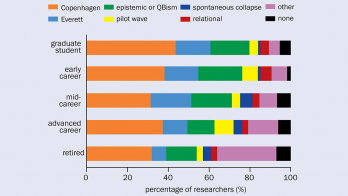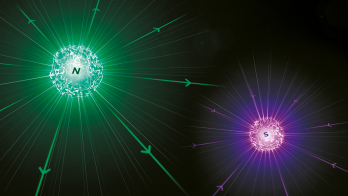by Shing-Tung Yau and Steve Nadis, Basic Books. Hardback ISBN 9780465020232, $30.

Geometry is the architecture of space, explains Shing-Tung Yau at the start of this book. For most of history, this architecture used the rigid straight lines inherited from Pythagoras, Euclid and other Ancient Greeks. Then, René Descartes, Carl Friedrich Gauss and Bernhard Riemann in turn showed how it could become more flexible.
Whichever way it was constructed, geometry remained largely abstract until almost 100 years ago, when Albert Einstein’s theory of general relativity showed how matter influences the space around it. Ever since this pioneer synthesis, mathematicians have been exploring the possibilities of geometry for physics, and vice versa. One early milestone was the attempt by Theodor Kaluza and Oskar Klein to extend space from four to five dimensions. Although their attempt to extract new physics failed, it has never stopped physicists and mathematicians from exploring the potential of multidimensional spaces.
In the same way that Einstein’s work revolutionized the theory of gravity, so in the closing years of the 20th century string theory emerged as a new way of viewing elementary particles and their various interactions. Unlike Brian Greene’s The Elegant Universe, this book is not an introduction to the physics fundamentals of string theory. Instead, it is more concerned with the mathematics that string theory uses.
In 1950, a geometer named Eugenio Calabi launched a bold new conjecture. More than a quarter of a century later, this conjecture was proved by Shing-Tung Yau, and the geometry has since been known as Calabi-Yau manifolds. The two names have become so closely associated that Yau wryly points out how many people assume that his first name is Calabi!
Following a description of such arcane mathematics is difficult, the proof even more so. However, it is dutifully done, in a way redolent of Simon Singh’s Fermat’s Last Theorem, which commendably made mathematics understandable without using equations. Some of Yau’s explanations are difficult to follow but a glossary of mathematical terms at the end of the book is a great help. The remainder of the book explains the potential of Calabi-Yau geometry as a framework for string theories – a subject that seems to have taken a place alongside rocket science as a perceived pinnacle of intellectual ingenuity.
While books with two co-authors are not unusual, this one is: one author writes a narrative in the first person, the other uses the third person. Nevertheless it works. For anyone interested in string theory it is a good book for understanding what has been achieved so far, and by whom (however, some notable contributions are missing). It is also a timely reminder of the latent power and elegance of mathematics. Calabi-Yau manifolds could help revolutionize our understanding of the world around us in the same way that Riemannian geometry did. However, while many great minds have chipped away at the problem, the ultimate latter-day Einstein has yet to emerge.







